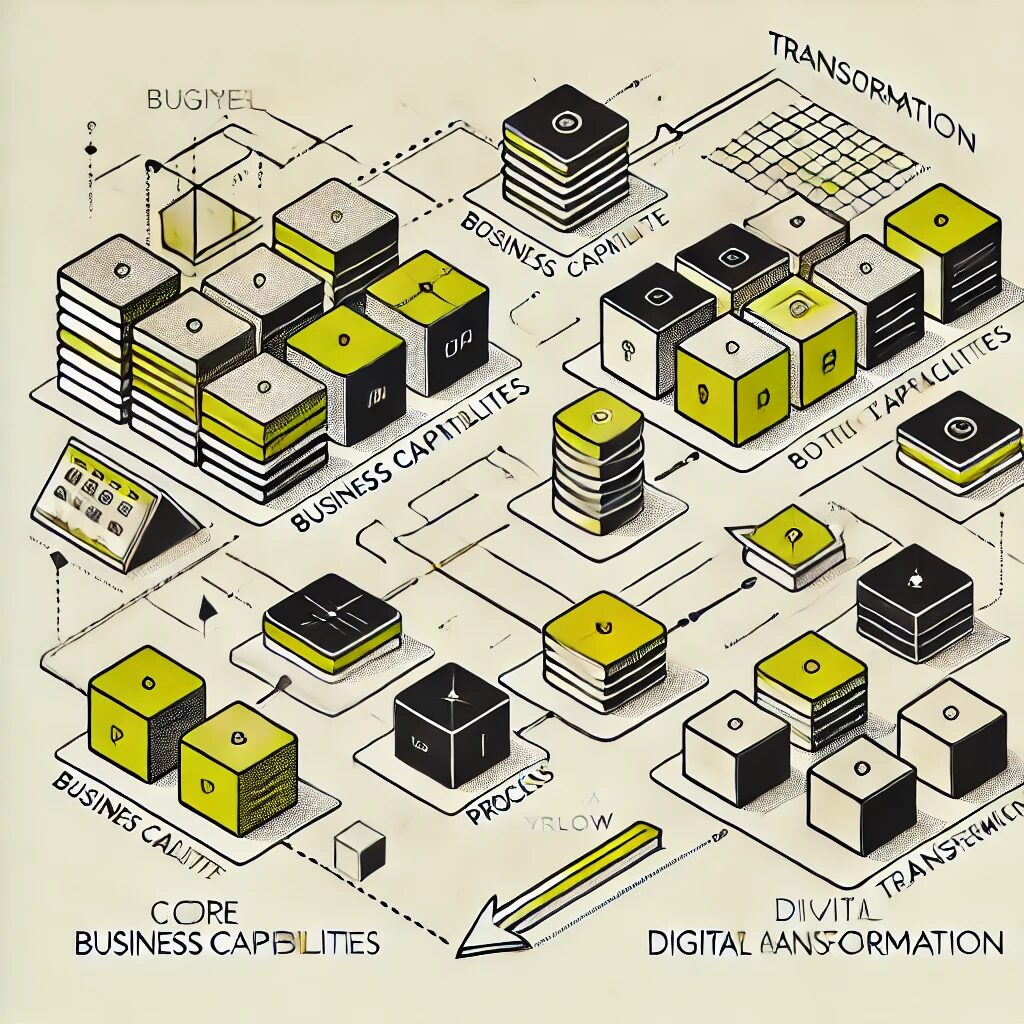
The Power of Business Capability Maps in the Software Sector. Transform Your Software Organization from Siloed Complexity to Strategic Coherence.
In today’s rapidly evolving software industry, companies struggle with operational inefficiencies and bloated IT landscapes that impede innovation, drive up costs, and create technical debt. Business Capability Maps provide a powerful solution by offering a comprehensive view of what your organization does—independent of how, who, or where—creating a stable foundation for optimization initiatives.
For software organizations facing pressure to accelerate delivery while controlling costs, capability mapping provides the essential framework to identify redundancies, prioritize investments, and create a streamlined operational model that aligns technology decisions with business priorities. By visualizing capabilities through a business lens rather than a technical one, organizations can transform complexity into strategic clarity.
1: Understanding Business Capabilities in the Software Context
Business capabilities represent the fundamental building blocks of what your software company does to deliver value. Unlike processes or technologies, capabilities provide a stable lens for viewing your organization’s core functions and competencies.
- Capability Definition Clarity: A business capability encapsulates what your organization does (the “what”) rather than how it’s done (the “how”), who does it (the “who”), or where it happens (the “where”).
- Structural Advantage: Software companies benefit from capability mapping because it cuts through rapidly changing technologies to focus on enduring business functions that remain relatively stable.
- Optimization Foundation: Capabilities provide the ideal framework for optimization because they directly connect to business outcomes rather than technical implementations.
- Architectural Bridge: Capability maps create a critical bridge between business strategy and technology architecture, ensuring alignment across all levels of the organization.
- Decision-Making Framework: When properly developed, capability maps provide an objective basis for crucial decisions about technology investments, operational improvements, and organizational design.
2: The Anatomy of an Effective Software Capability Map
A comprehensive capability map follows a hierarchical structure that enables both broad enterprise visibility and detailed functional understanding. This structured approach ensures the map serves multiple stakeholder needs.
- Level 1 – Capability Domains: The highest level captures major business areas such as Product Development, Customer Engagement, Revenue Management, and Business Operations.
- Level 2 – Capability Groups: Each domain decomposes into logical groups, such as “Product Development” containing Research & Innovation, Product Design, Engineering, Quality Assurance, and Release Management.
- Level 3 – Business Capabilities: These represent discrete business functions like Requirements Management, Architecture Design, Code Development, and Testing.
- Level 4 – Capability Components: The most granular level describes specific functions such as Unit Testing, Integration Testing, and Performance Testing within the Testing capability.
- Cross-Cutting Aspects: Effective maps also identify capabilities that span multiple domains, such as Security, Data Management, and Compliance.
Did You Know:
- According to The Open Group research, organizations with mature capability maps achieve 30% higher alignment between business strategies and IT investments compared to organizations without formalized capability mapping practices.
3: Exposing Operational Redundancies
One of the most immediate benefits of capability mapping is revealing duplicate capabilities across the organization. This visibility enables targeted consolidation that reduces costs while improving operational consistency.
- Functional Overlap Identification: Capability maps reveal where multiple business units have developed similar capabilities independently, creating unnecessary redundancy and inconsistent customer experiences.
- Technology Duplication Discovery: Mapping applications to capabilities exposes where multiple systems support the same business function, creating opportunities for rationalization and cost reduction.
- Process Inconsistency Recognition: Capability assessment reveals where the same capability is performed differently across business units, highlighting standardization opportunities.
- Organizational Redundancy Visualization: The capability lens exposes where multiple teams perform similar functions, creating opportunities for structural optimization.
- Consolidation Prioritization Framework: By assessing the maturity and strategic importance of redundant capabilities, organizations can prioritize consolidation efforts based on business impact.
4: Streamlining the Application Portfolio
For software companies, application portfolio bloat creates unnecessary complexity and cost. Capability mapping provides the foundation for rational portfolio decisions based on business value rather than technical factors alone.
- Application-to-Capability Mapping: Documenting which applications support which business capabilities reveals redundancies, gaps, and integration needs across your technology landscape.
- Rationalization Opportunity Identification: Capability maps expose where multiple applications support the same business function, creating clear targets for consolidation.
- Technical Debt Prioritization: Understanding which capabilities are supported by aging or fragile applications helps prioritize modernization efforts based on business impact.
- Build vs. Buy Decision Framework: Capability mapping establishes clear criteria for determining which capabilities warrant custom development versus commercial solutions.
- Architecture Governance Enhancement: Capability-based governance ensures new application investments align with strategic priorities rather than creating new silos.
5: Optimizing Technology Investments
Software companies face constant pressure to invest in new technologies. Capability mapping ensures these investments directly support business priorities rather than chasing technical trends.
- Investment Alignment Validation: Capability maps provide a clear framework for ensuring technology investments directly support strategically important business functions.
- Budget Allocation Optimization: By identifying capability gaps and redundancies, organizations can redirect resources from over-invested areas to under-supported strategic capabilities.
- Technology Roadmap Coherence: Capability-based planning ensures technology roadmaps address business needs in a logical sequence rather than responding to siloed demands.
- Innovation Focus Clarification: Mapping helps distinguish where technical innovation creates genuine competitive advantage versus where industry-standard solutions are sufficient.
- Vendor Management Enhancement: Capability mapping reveals where multiple vendors support similar functions, creating opportunities for strategic vendor consolidation and improved terms.
6: Streamlining Operational Processes
Beyond technology optimization, capability mapping drives operational efficiency by revealing process fragmentation, handoff issues, and accountability gaps. This visibility enables targeted process improvement.
- End-to-End Process Alignment: Capability maps connect fragmented processes across departmental boundaries, revealing opportunities to streamline workflows and eliminate handoff friction.
- Decision Rights Clarification: The capability lens helps define clear ownership for each business function, reducing decision delays and improving accountability.
- Standardization Opportunity Identification: Mapping reveals where inconsistent processes support the same capability across the organization, creating targets for beneficial standardization.
- Measurement Framework Development: Capability mapping enables consistent performance metrics that track outcomes rather than just departmental activities.
- Automation Prioritization: Understanding capabilities and their performance gaps helps prioritize where process automation delivers the greatest business impact.
7: Enabling Strategic Cost Optimization
Unlike tactical cost-cutting, capability-based optimization ensures cost reduction aligns with strategic priorities. This approach protects critical capabilities while identifying areas for responsible savings.
- Value-Based Cost Analysis: Capability mapping shifts cost discussions from departmental budgets to business value delivery, revealing where spending doesn’t align with strategic priorities.
- Consolidation Roadmap Development: Maps provide the foundation for sequenced consolidation of redundant capabilities, systems, and teams based on business impact and technical feasibility.
- Non-Strategic Outsourcing Identification: Capability assessment helps identify non-differentiating capabilities that can be outsourced to reduce costs without sacrificing competitive advantage.
- Resource Reallocation Framework: As redundancies are eliminated, capability maps help direct freed resources toward strategic capability gaps rather than across-the-board reductions.
- Investment Protection Mechanism: Capability-based optimization protects investment in truly strategic capabilities while targeting cuts in non-essential areas.
8: Accelerating Cloud Transformation
Software companies frequently struggle with cloud migration prioritization. Capability mapping provides the essential framework for strategic cloud transformation based on business value.
- Migration Priority Framework: Capability strategic importance and current performance gaps provide objective criteria for cloud migration sequencing.
- Service Model Alignment: Capability characteristics help determine the appropriate cloud service model (SaaS, PaaS, IaaS) for each supporting application.
- Transformation Dependency Mapping: Capability relationships reveal migration dependencies that influence transformation sequencing.
- Hybrid Optimization Strategy: Capability analysis helps identify which functions benefit from cloud deployment versus those better suited to remaining on-premises.
- Business Case Development: Capability-based cloud planning strengthens transformation business cases by connecting technical changes to business capability improvements.
Did You Know:
- According to Gartner research, organizations leveraging capability mapping for application portfolio rationalization achieve average savings of 15-20% in software licensing costs and 20-25% reduction in support costs within 18 months of implementation.
9: Enhancing Merger and Acquisition Success
Software industry consolidation requires effective approaches to integration. Capability mapping provides the ideal framework for evaluating acquisition targets and planning successful integration.
- Acquisition Capability Assessment: Evaluate potential acquisition targets based on how their capabilities complement or enhance your organization’s capability map.
- Integration Priority Identification: Determine which capabilities should be rapidly integrated, which can remain separate, and which might be maintained as centers of excellence.
- Redundancy Resolution Framework: Create objective criteria for resolving capability overlaps, ensuring decisions serve strategic objectives rather than organizational politics.
- Capability Transfer Methodology: Develop approaches for transferring tacit knowledge and expertise related to critical capabilities from acquired organizations.
- Synergy Realization Planning: Map-based integration planning enables more accurate synergy targets and realistic implementation timelines.
10: Data Architecture Optimization
For software companies, data proliferation creates complexity and compliance challenges. Capability mapping provides the context for data rationalization by connecting information assets to business needs.
- Data-to-Capability Connection: Mapping data assets to the capabilities they support reveals which information is truly business-critical versus nice-to-have.
- Master Data Rationalization: Capability mapping exposes where multiple systems maintain similar data, creating opportunities for master data consolidation.
- Governance Prioritization: Understanding which data supports strategic capabilities helps focus governance efforts on the most business-critical information.
- Analytics Capability Enhancement: Capability gaps in data exploitation reveal where enhanced analytics can deliver strategic advantage.
- Data Architecture Simplification: The capability lens helps identify redundant data stores and unnecessary data movements that can be eliminated.
11: Workforce Optimization and Skills Alignment
Software companies face constant talent challenges. Capability mapping helps align organizational structure and skills development with strategic business needs.
- Organizational Design Alignment: Capability mapping informs how teams should be structured around value streams rather than traditional functional silos.
- Critical Skill Identification: Assessment reveals capability gaps that require specific talent acquisition or development initiatives.
- Career Path Development: Capability maps provide the foundation for skill progression paths that connect individual development to organizational needs.
- Resource Allocation Optimization: Understanding capability performance helps direct limited talent resources to the highest-impact business functions.
- Strategic Workforce Planning: Capability evolution forecasting enables proactive talent strategy rather than reactive hiring.
12: Optimizing the Development Lifecycle
Software development efficiency directly impacts market responsiveness. Capability mapping reveals optimization opportunities across the entire development value stream.
- Value Stream Friction Identification: Mapping development capabilities reveals handoff issues, wait states, and process inefficiencies that delay delivery.
- Reusable Component Opportunity: Capability analysis exposes where common software components could be developed once and reused across products.
- Automation Investment Prioritization: Capability performance assessment identifies manual development activities with the highest automation return on investment.
- Quality Enhancement Focus: Mapping reveals capability gaps in quality processes that contribute to defects and technical debt.
- Delivery Cadence Optimization: Capability-based planning helps synchronize interdependent development activities to improve release predictability.
13: Security and Compliance Streamlining
Software companies face complex security and compliance requirements. Capability mapping helps rationalize these functions to ensure comprehensive coverage without unnecessary duplication.
- Security Control Rationalization: Mapping security capabilities reveals overlapping controls that can be consolidated to reduce complexity while maintaining protection.
- Compliance Requirement Integration: The capability lens helps identify common compliance requirements across regulations, enabling unified rather than siloed compliance approaches.
- Risk-Based Investment Prioritization: Capability mapping enables security investment prioritization based on business criticality rather than technical vulnerability alone.
- Security Architecture Simplification: Understanding capability relationships helps eliminate redundant security mechanisms while ensuring comprehensive protection.
- Audit Efficiency Enhancement: Capability-based security documentation streamlines audit processes by providing clear traceability from controls to business functions.
14: Product Portfolio Optimization
Software companies must continuously evolve their product offerings. Capability mapping provides the foundation for strategic product decisions that maximize development leverage.
- Capability Reuse Analysis: Mapping reveals common capabilities across products that should leverage shared components rather than independent implementations.
- Feature Consolidation Opportunity: Capability assessment exposes similar features implemented differently across products, creating standardization opportunities.
- Product Rationalization Framework: Understanding capability overlap across products helps identify candidates for consolidation or retirement.
- Roadmap Alignment Enhancement: Capability-based planning ensures product roadmaps build complementary capabilities rather than creating redundant investments.
- Build vs. Buy Optimization: Capability analysis provides clear criteria for determining which product features warrant custom development versus third-party integration.
15: Creating a Culture of Continuous Optimization
Sustainable optimization requires embedded practices rather than one-time initiatives. Capability mapping enables an ongoing optimization culture by providing a stable framework amid constant change.
- Governance Integration: Embed capability assessment in standard governance processes for technology investments, ensuring optimization becomes business-as-usual.
- Performance Metric Alignment: Connect operational metrics directly to capability performance, creating ongoing visibility into optimization opportunities.
- Regular Assessment Cadence: Establish routine capability assessments aligned with planning cycles to continuously identify new optimization targets.
- Recognition Mechanism Development: Create incentives that reward cross-functional collaboration on capability optimization rather than just departmental efficiency.
- Capability Evolution Management: Develop processes for regularly updating the capability map itself as business models and strategic priorities evolve.
Did You Know:
- According to McKinsey research, organizations that integrate capability-based optimization into standard governance processes achieve 40% more sustained cost savings than those implementing one-time rationalization projects.
Takeaway
Business Capability Maps transform software companies’ approach to operational and IT optimization from reactive, siloed efforts to strategic, enterprise-wide initiatives. By providing a stable business lens independent of organizational structures and technologies, capability mapping enables objective identification of redundancies, gaps, and improvement opportunities across processes, applications, data, and teams. This holistic approach ensures optimization initiatives deliver sustainable value by aligning with strategic priorities rather than simply cutting costs. Whether addressing application portfolio bloat, process inefficiencies, or organizational redundancies, capability mapping provides the essential framework for decisions that enhance operational excellence while supporting strategic objectives.
Next Steps
- Assess Your Current State: Inventory existing documentation that could inform your capability map, including strategic plans, process models, and system catalogs.
- Develop a Core Team: Assemble a cross-functional team with business and IT representation to lead your capability mapping initiative.
- Start with Strategic Priorities: Begin mapping the capabilities most relevant to current strategic initiatives rather than attempting to document everything at once.
- Connect to Immediate Decisions: Apply the evolving map to a pressing optimization challenge to demonstrate value while the mapping effort continues.
- Establish Governance: Integrate capability assessment into your standard technology and business governance processes to sustain optimization momentum.



